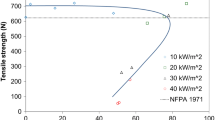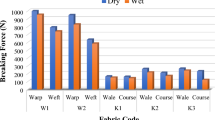Abstract
As most textile tests are destructive, non-destructive test (NDT) methods are needed to evaluate in-use firefighters’ protective clothing and to provide guidance as to when to replace this clothing. One NDT method that has shown promise is near-infrared (NIR) spectroscopy. The focus of this research was to examine methods that can be used to analyze spectral data to develop correlations between NIR results and remaining tensile strength of three different Kevlar®/PBI outer shell fabrics after 30–300 s exposures of 10–70 kW/m2 in the cone calorimeter. Four methods of analyzing NIR data were considered: shifts in absorbance at a particular wavelength, changes to absorbance features (area and prominence), and changes to the slope of reflectance curves based on a normalized difference index (NDI) method. While each method had its advantages and disadvantages, the NDI method showed the most promise of the methods considered here, as there were clear trends across the three fabrics over the entire heat flux range. It could also be implemented using measurements at two wavelengths, which would assist in developing a practical device for evaluation of firefighters’ protective clothing in the field.















Similar content being viewed by others
References
Canadian General Standards Board (2001) CAN/CGSB-155.1–2001 Firefighter’s protective clothing for protection against heat and flame. Standards Council of Canada, Ottawa, ON
National Fire Protection Association (2013) NFPA 1971 Standard on protective ensemble for structural firefighting and proximity fire fighting. Quincy, MA
Fulton M, Rezazadeh M, Torvi D (2018) Tests for evaluating textile aging. In: Dolez P, Vermeersch O, Izquierdo V (eds) Advanced characterization and testing of textiles. Elsevier, Duxford, pp 93–125
National Fire Protection Association (2020) NFPA 1851 Standard on selection, care, and maintenance of protective ensembles for structural fire fighting and proximity fire fighting. Quincy, MA
Slater K (1991) Textile degradation. Text Prog 21(1):1–150
Chalmers JM, Griffiths PR (2001) Handbook of vibrational spectroscopy. Wiley, New York
McClure F (2004) Review: 204 years of near infrared technology 1800–2003. J Near Infrared Spectrosc 11(6):487–518
Arrieta C, David E, Dolez P, Vu-Khanh T (2010) Thermal aging of a blend of high-performance fibres. J Appl Polym Sci 93(5):3031–3039
Arrieta C, David E, Dolez P, Vu-Khanh T (2011) Hydrolytic and photochemical aging studies of a Kevlar®-PBI blend. Polym Degrad Stab 96(8):1411–1419
Dolez P, Tomer NS, Malajati YA (2019) Quantitative method to compare the effect of thermal aging on the mechanical performance of fire protective fabrics. J Appl Polym Sci 136:47045
Ormond RB, Gabler WJ (2017) Non-destructive assessment of outer shell deterioration for firefighter turnouts. Fire Protection Research Foundation, Quincy, MA
Richardson E, Martin G, Wyeth P, Zhang X (2008) State of the art: non-invasive interrogation of textiles in museum collections. Microchim Acta 162(2):303–312
Garside P, Wyeth P, Zhang X (2011) Use of near IR spectroscopy and chemometrics to assess the tensile strength of historic silk. e-PRESERVATION Sci 8:68–73
Fortier C, Montalvo J, Von Hoven T, Easson M, Rodgers J, Condon B (2014) Preliminary evidence of oxidation in standard oven drying of cotton: attenuated total reflectance/Fourier transform infrared spectroscopy, colorimetry, and particulate matter formation. Text Res J 84:157–173
Davis R, Chin J, Lin C, Petit S (2010) Accelerated weathering of polyaramid and polybenzimidazole firefighter protective clothing fabrics. Polym Degrad Stab 95(9):1642–1654
Nazare S, Davis RD, Peng JS, Chin J (2012) Accelerated weathering of firefighter protective clothing: delineating the impact of thermal, moisture, and ultraviolet light exposures. NIST technical note 1746, National Institute of Standards and Technology, Gaithersburg, MD
Cai G, Yu W (2011) Study on the thermal degradation of high performance fibers by TG/FTIR and Py-GC/MS. J Therm Anal Calorim 104(2):757–763
Rezazadeh M, Bespflug CJ, Torvi DA, Noble SD, Fulton M (2018) Predicting mechanical strength of in-use firefighter protective clothing using near-infrared spectroscopy. Fire Technol 54:1759–1781
Rodgers J, Fortier C, Montalvo J, Cui X, Kang SY, Martin V (2010) Near infrared measurements of cotton fiber micronaire by portable near infrared instrumentation. Text Res J 80:1503–1515
Bespflug CJ, Torvi DA, Noble SD, Fulton M, Vanderschaaf CJ, Batcheller J (2020) The impact of soiling, moisture, abrasion and UV exposure on NIR evaluation of in-use firefighter protective clothing. In: Lehtonen K, Shiels B, Ormond B (eds) Performance of protective clothing and equipment: 11th volume, innovative solutions to evolving challenges, ASTM STP 1624. ASTM International, West Conshohocken, PA, pp 40–63
Fulton M (2017) Evaluating the performance of thermally and UV aged firefighters’ protective clothing using both destructive and non-destructive methods. Thesis, University of Saskatchewan
Canadian General Standards Board (2004) CAN/CGSB 4.2 No. 58-2004 Textile test methods: dimensional change in domestic laundering of textiles. Ottawa, ON
Ohalele H (2020) Evaluating effects of heat fluxes and duration on performance of firefighters’ protective clothing using destructive and non destructive methods. Thesis, University of Saskatchewan
ASTM International (2016) ASTM D1776-16 Standard practice for conditioning and testing textiles. West Conshohocken, PA
ASTM International (2012) ASTM E104-02 Standard practice for maintaining constant relative humidity by means of aqueous solutions. West Conshohocken, PA
Torvi D, Rezazadeh M, Bespflug C (2016) Effects of convective and radiative heat sources on thermal response of single and multiple-layer protective fabrics. In: Shiels B, Lehtonen K (eds) Performance of protective clothing and equipment: 10th volume, risk reduction through research and testing, ASTM STP 1593. ASTM International, West Conshohocken, PA, pp 131–158
ASTM International (2015) ASTM D5035-11 Standard test method for breaking force and elongation of textile fabrics (strip method). West Conshohocken, PA
ASTM International (2013) ASTM D5034-09 Standard test method for breaking strength and elongation of textile fabrics (grab test). West Conshohocken, PA
Rezazadeh M (2014) Evaluation of performance of in-use firefighters’ protective clothing using non-destructive tests. Dissertation, University of Saskatchewan
Workman JJ, Weyer L (2012) Practical guide and spectral atlas for interpretive near-infrared spectroscopy. CRC Press, Boca Raton
Clark RN, Roush TL (1984) Reflectance spectroscopy: quantitative analysis techniques for remote sensing applications. J Geophys Res 89(B7):6329–6340
Gau B (1996) NDWI - a normalized difference water index for remote sensing of vegetation liquid water from space. Remote Sens Environ 58(3):257–266
Acknowledgements
This work was funded by the Natural Sciences and Engineering Research Council of Canada (Grant Number RGPIN-2015-05911), and the University of Saskatchewan’s Department of Mechanical Engineering, College of Engineering, and College of Graduate and Postdoctoral Studies. The authors would like to acknowledge the technical contributions of Dr. Melanie Fauchoux, Chris Bespflug, Hayden Reitenbach and Shawn Reinink of the Department of Mechanical Engineering and Prof. Robert Scott of the Department of Chemistry at the University of Saskatchewan, and Mark Ackerman and Stephen Paskaluk of the University of Alberta. They would also like to thank PBI Performance Products, Inc. for their donation of materials for this research.
Author information
Authors and Affiliations
Corresponding author
Ethics declarations
Conflicts of interest
The authors declare that they have no conflict of interest.
Additional information
Publisher's Note
Springer Nature remains neutral with regard to jurisdictional claims in published maps and institutional affiliations.
Rights and permissions
About this article
Cite this article
Ohalele, H.U., Fulton, M., Torvi, D.A. et al. Comparison of Techniques for Prediction of Mechanical Strength of Firefighters’ Protective Clothing Using Near-Infrared Spectral Data. Fire Technol 58, 591–613 (2022). https://doi.org/10.1007/s10694-021-01161-7
Received:
Accepted:
Published:
Issue Date:
DOI: https://doi.org/10.1007/s10694-021-01161-7




